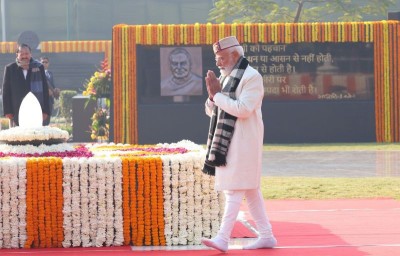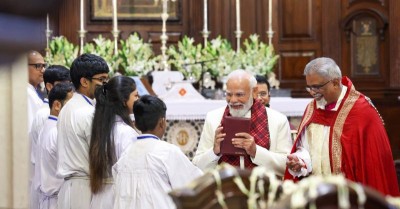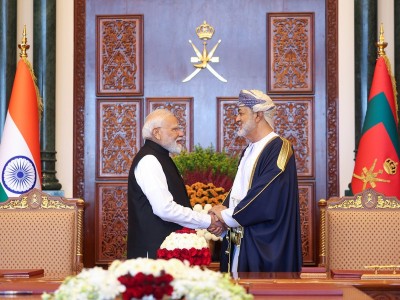
Northeast: A Pale Islamist Shadow
During a span of 11 days, between September 13 and September 23, 2018, Security Forces (SFs) arrested nine Hizb-ul-Mujahideen (HM) cadres, all residents of Assam. The first arrest took place on September 13, when a trained HM cadre, Qamar-uz-Zaman, was arrested from Shivnagar locality in Kanpur District of Uttar Pradesh. Zaman hails from Jamunamukh in Hojai District of Assam. The Uttar Pradesh Police and National Investigation Agency (NIA) subsequently alerted authorities in Assam about the arrest.
On September 14, Police arrested Shahnawaz Alam from Nilbagan in the Hojai District of Assam. On September 15, Police arrested SaidulAlam, a resident of the Lanka region in Hojai District, from Udali in Nagaon District (Assam). On the same day, Police arrested Omar Faruk near Byrnihat along the Assam-Meghalaya border. On September 17, Police arrested Zaman's elder brother Saiful Islam,and recovered INR 106,000 from his house in Jamunamukh in Hojai District. Police sources disclosed that Saiful Islam was detained by the Police on September 15 and was interrogated till his arrest. On September 18, Police arrested another three persons, Baharul Islam, Riyazuddin Bhuyan and Joynal Ahmed from Hojai District.
On September 18, 2018, Ankur Jain, Superintendent of Police (SP),Hojai District,stated:
We are now trying to dig out the root of Hizb-ul-Mujahideen in Assam. So far, we have arrested seven persons and each one of them is being interrogated by our Special Investigation Team (SIT). We have the information and all we have to do is to join the dots. Shahnwaz Alam so far has turned out to be one of the who's who of Hizb-ul-Mujahideen.
Later, on September 23, a linkman of HM, identified as Abhumanyu Chouhan was arrested from Mosoka under Kheroni Police Station in Karbi Anglong District.
HM was reportedly attempting to supply sophisticated arms, including AK 47 assault rifles, for its operatives in the State. Sources said that the arms procurement process had already begun and there might be some links with dealers based in Nagaland in the entire process. An unnamed senior Police official added, “As per our report, the outfit could not execute its plan to supply arms but then we are not ruling out any possibility. Many new revelations have come up during the questioning.”
The quick arrest of six HM militants within a week of the initial arrest in Uttar Pradesh and continuing investigations into their disclosures are likely to bring this incipient movement to an end. There is little evidence of any sustainable network associated with HM in Assam, and the present cluster is likely to have been a one-off development, based on individual associations developed by Zaman, who had gone to Kashmir’s Kishtwar District as a petty trader in 2013, and had subsequently joined HM.
The arrest of Islamist militants is, however, not a new phenomenon in Assam. A long list of Islamist outfits has been operating in Assam since the 1990’s. The rise of Islamist militancy started in North Eastern India in the wake of the 1992 Babri Masjid demolition and the subsequent communal disturbances; as well as because of Manipur's infamous Meitei-Muslim riots in 1993. Pakistan’s’ Inter-Services Intelligence (ISI), relentless in its design to exploit India’s vulnerabilities, received help from the regime in Bangladesh, which, at that time, was deeply hostile to India. A hotbed of Islamist radicalization and militancy, Bangladesh was used by ISI to extend its proxy war against India – a situation that has changed dramatically in New Delhi’s favour since the Sheikh Hasina Government assumed office in 2009.
A majority of Islamic militant groups in the Northeast were founded between 1990 and 1996, with the proclaimed objective of ‘safeguarding the overall interests’ of the minority Muslim communities in the region. More groups surfaced in the early 2000s, but these were short-lived.
Nevertheless, trace activities of Islamist extremists persist. According to partial data compiled by the South Asia Terrorism Portal (SATP), at least 109 Islamist extremists have been arrested across the Northeast since 2015 (data till September 23, 2018). These include 57 cadres in 2015 [20 Bangladesh-based Jama'atul Mujahideen Bangladesh (JMB), 19 Muslim Tiger Force of Assam (MTFA), 10 Muslim United Liberation Tigers of Assam [MULTA], one cadre each of Muslim Liberation Army (MLA) and Peoples United Liberation Front (PULF), and six others (group not identified)];36 cadres in 2016 [24 JMB, six MTFA, one each of the Islamic State of Iraq and Syria (ISIS), MULTA, Indian Mujahideen (IM), and three others (group not identified)];six cadres in 2017 [five MULTA, one JMB. At least 10 Islamist extremists, including eight HM, two MULTA, have been arrested thus far in 2018 (data till September 23, 2018).
In addition, State Parliamentary Affairs Minister Rockybul Hussain had informed the State Assembly on December 15, 2014, that between January 2001 and November 2014, a total of 130 Islamist extremists, including 106 MULTA cadres, 14 of Harakat-ul-Mujahideen (HuM), and 10 of JMB, were arrested in Assam.On December 8, 2015, Rockybul Hussain had informed the State Assembly that three Islamist militant groups, MULTA, JMB, and HuM, were active in the State.
During the Assam violence in July 2012, the Central Government identified at least 19 Islamist organisations to watch in connection with violence in the State. The list included 14 groups from Assam: Muslim Security Council of Assam (MSCA), United Liberation Militia of Assam (ULMA),Islamic Liberation Army of Assam(ILAA), Muslim Volunteer Force (MVF), Muslim Liberation Army (MLA), Muslim Security Force (MSF), Islamic Sevak Sanng (ISS), Islamic United Reformation Protest of India (IURPI), Revolutionary Muslim Commandos (RMC), Muslim Tiger Force (MTF), Muslim Liberation Front (MLF), Muslim Liberation Tigers of Assam (MLTA), Muslim United Liberation Front of Assam (MULFA)and MULTA. There were five groups from Manipur in the list: Islamic National Front (INF), Islamic Revolutionary Front (IRF), United Islamic Liberation Army (UILA), United Islamic Revolutionary Army (UIRA) and PULF.
According to SATP, at least 20 Islamist terror formations have operated in Assam at different periods.
Historically, the most active among these groups were MULTA, and the People's United Liberation Front [PULF]. While the former confined its activities to Assam, the latter operated in Manipur and in the adjoining Districts of south Assam. Their presence has also been felt in the neighbouring States of Nagaland and Meghalaya. At one time, Harakat-ul-Mujahideen (HuM) was also very active along with Harkat-ul-Jihad-al-Islami (HuJI). Around 500 militants mostly belonging to MULTA, PULF, and HuM either surrendered or were arrested in Assam and Manipur between 1999 and 2004, after which very limited activity has been noticed by the surviving elements of these groupings.
The presence of JMB in Assam was exposed after the discovery of the Burdwan Module in West Bengal. An accidental explosion at Burdwan on October 2, 2014, in which two JMB militants were killed and another was injured. NIA claimed that, during the course of investigations, it had been found that operatives of JMB had established their networks in different Districts of Assam, Jharkhand, and West Bengal. According to the NIA Charge sheets, five accused in the case belonged to State of Assam. The NIA also claimed that JMB operatives
…were engaged in preparation of bombs, ammunition/arms, maintaining hideouts and organizing terrorist training camps in pursuance of a larger conspiracy to organise terrorist attacks in different parts of India and in Bangladesh.
One of the charge sheeted persons, Lal Mohammed aka Ibrahim, a JMB cadre arrested by Jharkhand Police on April 18, 2015 (NIA officially arrested him on April 27, 2015), reportedly revealed to interrogators that JMB’s sabotage plans in Assam were intended to counter Bodo ‘aggression’. Similarly, reports indicated that MTFA was formed to take 'revenge’ for the massacre of Muslims in the Bodoland Territorial Area Districts (BTAD) in May 2014.
Earlier on December 24, 2017, a report had mentioned that intelligence agencies had intercepted messages by the Kerala-based extremist Popular Front of India (PFI) sent to West Asian countries, linked to a campaign launched against the updating of the National Register of Citizens (NRC). According to reports, PFI is currently active in Goalpara, Karimganj, Silchar, Hailakandi, Kamrup, Borpeta, Baksa, Chirang, Kokrajhar, Dhubri, South Salmara, Lakhimpur, Nagaon and Tinsukia Districts of Assam.
According to a report published on June 30, 2018, the process of updating the NRC in Assam has provoked some radical Islamist outfits to step up their activities in areas inhabited by suspected illegal migrants. Inputs received by security agencies suggest that organisations from the country’s south are on overdrive to expand their base among the community through 'philanthropic activities', such as the distribution of textbooks and blankets. While these organisations were initially confined to Goalpara and Darrang, their activities have now expanded to include Karimganj, Chirang and Baksa. A students’ wing floated by one of these groups has also been making efforts to enrol students in Guwahati.
Pallab Bhattacharya, the then Additional Director General of Assam Police in charge of the Special Branch, said that the NRC has offered scope to many organisations to 'fish in troubled waters': “The recent conference by the SIO (Students Islamic Organisation) at the Delhi press club is an example, as is the raising of the NRC issue at the level of the United Nations.”
Earlier, a June 20, 2018, report claimed that ISI had activated sleeper cells in Assam to cause disturbances after the NRC is completed. There are previous instances when ISI agents were apprehended in the State. For example, on August 10, 1999, four ISI agents identified as Fasih Ullah Hussain, Javed Musaffar, Maulana Hafiz Mohammed. Akram Mallick and Qari Salim Ahmed were arrested from Guwahati. On June 22, 2007, 13 suspected ISI agents were arrested by the Army in North Cachar District. On October 15, 2012, SFs arrested a suspected ISI agent, identified as Akhtar Hussain, in Dhemaji District.
Major global Islamist terrorist groups such as al Qaeda and the Islamic State have also long been eying the region. Osama bin Laden’s 1996 fatwa, "Declaration of War against the Americans Occupying the Land of the Two Holy Places," first mentioned Assam. Again, at the time of its formation in September 2014, al Qaeda in the Indian Subcontinent (AQIS) specifically listed Assam among the target for jihad, along with Gujarat and Jammu and Kashmir. Similarly, in June 2014, the Islamic State issued a map project the regions of the world that it planned to dominate over the succeeding five years, which included all of India in its projected Khorasan Vilayat. There is, however, no visible sign of the presence of these formations in Assam.
Despite the long list of Islamist militant groupspresent in Assam, no operational successes have marked their existence in the past years, suggesting an absence of operational capabilities, as well as the ability of law enforcement agencies in countering their embryonic plots. The loss of Bangladesh as a safe haven and launching pad has also made any consolidation difficult. Indeed, Bangladeshi extremists formations such as JMB now see India’s Northeast as a refuge and escapefrom the crackdown in their own country, rather than as an area of potential operations.
There has been a consolidation of peace in Assam,which has experienced a multiplicity of ethnic insurgencies since 1979. With ethnic insurgent violence in its last leg, it is unlikely that Islamist formations will find any easy ground to operate in the State. The discovery and neutralization of the HM cell is an isolated incident, unlikely to auger any new trend.
Support Our Journalism
We cannot do without you.. your contribution supports unbiased journalism
IBNS is not driven by any ism- not wokeism, not racism, not skewed secularism, not hyper right-wing or left liberal ideals, nor by any hardline religious beliefs or hyper nationalism. We want to serve you good old objective news, as they are. We do not judge or preach. We let people decide for themselves. We only try to present factual and well-sourced news.







